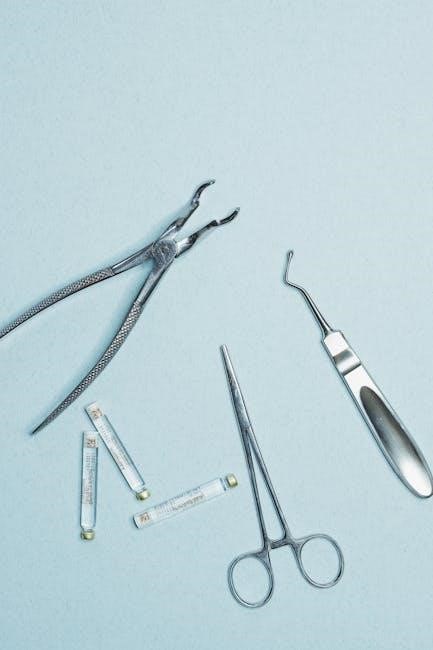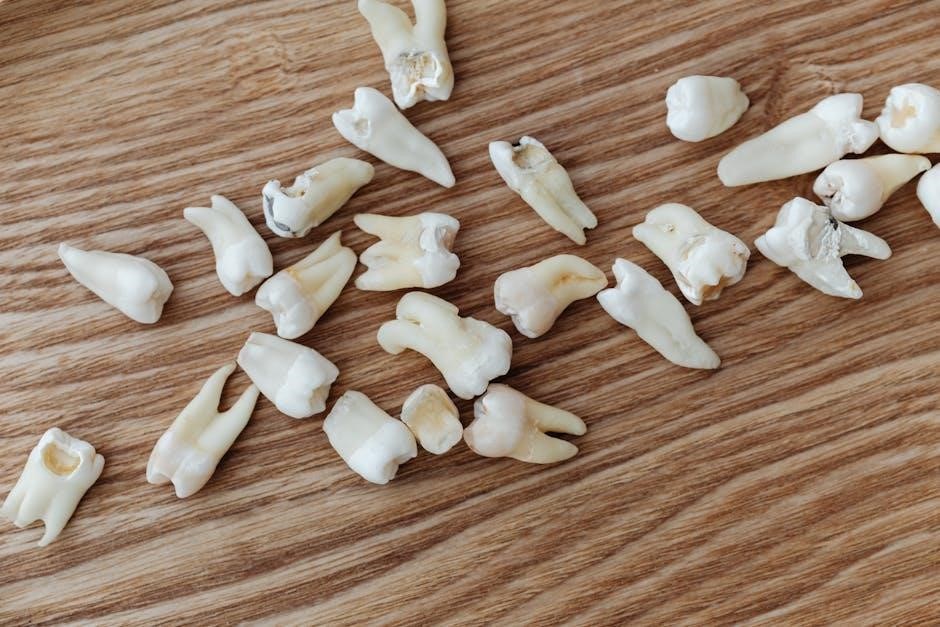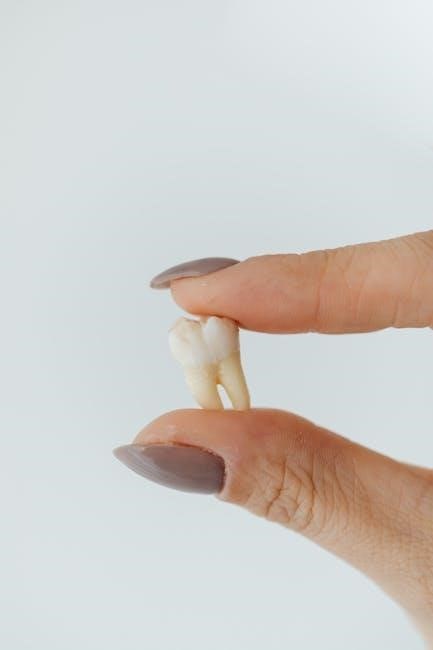Immediate Post-Operative Care
After dental extraction, keep gauze in place to control bleeding. Avoid spitting or rinsing for 24 hours. Rest and elevate your head to reduce swelling. Apply ice packs near the surgical area for 20 minutes every hour during the first 48 hours. Do not lie flat or engage in strenuous activities on the day of surgery. Eat soft foods and avoid hot beverages until healing begins. Bite gently on the gauze for 30 minutes to secure clot formation.
1.1 Managing Bleeding
After tooth extraction, bleeding is normal but should be controlled. Bite firmly on the gauze for 30-45 minutes to form a clot. If bleeding continues, replace the gauze with a clean one and apply pressure. Avoid spitting, rinsing, or drinking through a straw for 24 hours, as this can dislodge the clot. If bleeding increases, apply a moistened tea bag to the area and bite firmly for another 30 minutes. Elevated head position and ice packs near the surgical site can help reduce bleeding and swelling. If bleeding persists or becomes heavy, contact your dentist immediately.
1.2 Importance of Rest
Rest is crucial after dental extraction to promote healing and prevent complications. Avoid strenuous activities, exercise, or bending for 24 hours. Lie with your head elevated using pillows to reduce swelling and bleeding. Refrain from driving or operating machinery, especially if you’ve been sedated. A calm environment helps your body recover faster. Avoid talking excessively or making sudden movements that may dislodge the clot. Resting allows your body to heal efficiently, reducing the risk of prolonged bleeding or discomfort. Resume normal activities gradually, as advised by your dentist, ensuring proper recovery.

Dietary Recommendations
Avoid hard, spicy, or hot foods initially. Opt for soft, lukewarm meals like yogurt, mashed potatoes, and soups. Stay hydrated with lukewarm liquids, but avoid alcohol.
2.1 Foods to Avoid
After dental extraction, avoid hard, hot, or spicy foods that can dislodge the clot or irritate the surgical site. Avoid chewing ice, nuts, or hard seeds. Refrain from consuming alcohol or smoking, as these can delay healing. Skip sharp or crunchy foods like chips or raw vegetables. Do not drink through a straw, as suction can dislodge the clot. Avoid overly acidic or sticky foods that may stick to the wound. Stay away from hot beverages for 24 hours. These precautions help protect the healing area and prevent complications. Opt for soft, lukewarm, and non-irritating foods during the initial recovery period.
2.2 Recommended Foods
After dental extraction, focus on soft, nutrient-rich foods to promote healing. Opt for yogurt, scrambled eggs, and mashed bananas. Soups like broth or vegetable soup are ideal, as are smoothies made with fruits and vegetables. Eat soft-cooked pasta, oatmeal, or rice. Applesauce and avocados are also good choices. Cold foods like ice cream can help reduce swelling but should be consumed in moderation. Ensure meals are gentle on the surgical site and avoid chewing near the extraction area. Stay hydrated with water or clear, non-acidic juices; A balanced diet supports recovery and prevents discomfort during the healing process.

Oral Hygiene
Resume brushing gently the day after surgery, avoiding the surgical site. Start saltwater rinses (1/2 teaspoon salt in 8 oz warm water) the next day to clean the area.
3.1 Resuming Brushing
Start brushing gently the day after surgery, focusing on unaffected areas. Be cautious around the surgical site to avoid dislodging the clot. Use a soft-bristle toothbrush and mild toothpaste. Brush all teeth normally, even if sensitive, to maintain oral hygiene. Avoid vigorous brushing near the extraction site until healed. Resume your regular brushing routine after 24 hours, ensuring not to irritate the surgical area. This helps prevent infection and promotes healing while keeping your mouth clean and fresh.
3.2 Saltwater Rinses
Begin saltwater rinses 24 hours after surgery to promote healing. Mix ½ teaspoon of salt in 8 ounces of warm water. Rinse gently 3 times a day, especially after meals, to clean the surgical area. Avoid forceful swishing to prevent dislodging the clot. Continue this routine until the site is fully healed. Saltwater helps reduce swelling, kill bacteria, and soothe discomfort. It’s a simple yet effective way to maintain oral hygiene and support recovery after dental extraction.

Pain and Discomfort Management
Take prescribed pain medication as directed. Use ice packs to reduce swelling and discomfort. Avoid smoking and alcohol to promote healing and minimize pain.
4.1 Medication Advice
It is important to follow your dentist’s instructions regarding pain medication after a dental extraction. Over-the-counter pain relievers such as ibuprofen or acetaminophen are usually recommended to manage mild to moderate discomfort. If prescribed, stronger medications should be taken as directed to ensure effectiveness and safety. Avoid combining pain medications without consulting your dentist, as this can lead to adverse side effects. It is also crucial to complete the full course of any prescribed antibiotics to prevent infection and promote healing. Always inform your dentist of any allergies or sensitivities to medications before they are prescribed.
4.2 Managing Swelling
To reduce swelling after a dental extraction, apply an ice pack to the affected area for 20 minutes, then remove it for 10 minutes. Repeat this process for the first 48 hours. Keep your head elevated while resting or sleeping to minimize swelling. Avoid strenuous activities, as they can increase blood flow and swelling. Swelling typically peaks within the first 48 hours and then gradually subsides. If swelling becomes severe or persists, contact your dentist for further evaluation. Following these steps will help ensure a smoother recovery and reduce discomfort.
Physical Activity
Avoid intense exercise on the day of surgery. Rest and avoid strenuous activities to promote healing. Light activities can resume after a few days, as tolerated.
5.1 Avoiding Intense Exercise
Refrain from intense physical activity for at least 24 hours after extraction. Avoid activities that could dislodge the blood clot or cause bleeding. Strenuous exercise like running or heavy lifting can dislodge the clot, leading to complications. Light walking is acceptable if comfortable. Overexertion can prolong healing and increase swelling. Rest is crucial for proper recovery. Consult your dentist before resuming normal exercise routines. Avoid activities that involve bending or heavy lifting. Keeping activity levels low helps ensure a smooth recovery process. Prioritize rest to allow the extraction site to heal properly.
5.2 Recommended Activities
Engage in light, non-strenuous activities to promote recovery without disrupting the healing process. Gentle walking, reading, or watching TV is acceptable. Avoid bending or lifting heavy objects. Resting with your head elevated can reduce swelling. Light stretching or yoga, if comfortable, can be done cautiously. Prioritize relaxation and avoid activities that may dislodge the blood clot. Keeping activities minimal helps ensure proper healing. Listen to your body and avoid overexertion. Rest is key during the initial recovery phase. Gentle movements can help maintain mobility without risking complications. Focus on calm, low-energy tasks to support your recovery process effectively.

Follow-Up Care
Attend all scheduled follow-up appointments to monitor healing progress. Your dentist will check for proper clot formation and removal of sutures if necessary. This ensures a smooth recovery.
6.1 Importance of Follow-Up Appointments
Follow-up appointments are crucial after dental extraction to ensure proper healing and prevent complications. Your dentist will assess the healing progress, remove any sutures, and check for signs of infection or dry socket. These visits allow early detection of issues, ensuring timely intervention. Regular check-ups help maintain oral health and confirm that the extraction site is healing as expected. Failing to attend follow-up appointments may lead to prolonged recovery or additional treatments. Always adhere to your dentist’s schedule for a smooth and successful recovery process following your procedure.
6.2 Signs of Complications
Monitor for signs of complications after dental extraction, such as increased swelling, severe pain, or excessive bleeding that doesn’t subside. Infection symptoms include redness, pus, or a foul odor from the extraction site. A dry socket, characterized by intense pain and exposed bone, may develop if the blood clot dislodges. Fever, chills, or difficulty opening the mouth are indicators of infection. Numbness or tingling in the lips, tongue, or face could signal nerve damage. If you experience any of these, contact your dentist immediately; Prompt intervention is essential to address complications and ensure proper healing.

Additional Considerations
Avoid using straws, smoking, or consuming alcohol for 24 hours. Stick to soft foods and stay hydrated to promote healing and prevent complications.
7.1 Avoiding Smoking and Alcohol
Smoking and alcohol consumption should be avoided for at least 24 hours after dental extraction. Smoking can dislodge the blood clot, leading to dry socket and delayed healing. Alcohol irritates the wound, increasing the risk of infection and prolonging recovery. Avoid using straws to drink, as the suction can disturb the surgical site. Resuming these habits too soon may compromise healing and lead to complications. It is recommended to wait a few days before cautiously reintroducing alcohol or smoking to ensure proper healing. Your dentist may provide specific guidance based on your recovery progress.
7.2 Managing Swelling with Ice
To reduce swelling after dental extraction, apply an ice pack to the affected area. Use a cloth-wrapped ice bag or a cold compress. Apply for 20 minutes, then remove for 10 minutes. Repeat this cycle as needed during the first 48 hours. Ice helps minimize inflammation and eases discomfort. Ensure the ice does not directly touch the skin to avoid tissue damage. Continue this practice until swelling subsides. If swelling persists or worsens, consult your dentist for further evaluation and guidance. This method is effective and safe when followed correctly.

No Responses